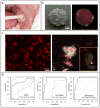Current development of saliva/oral fluid-based diagnostics
- PMID: 20737986
- PMCID: PMC3742318
Current development of saliva/oral fluid-based diagnostics
Abstract
Saliva can be easily obtained in medical and non-medical settings, and contains numerous bio-molecules, including those typically found in serum for disease detection and monitoring. In the past two decades, the achievements of high-throughput approaches afforded by biotechnology and nanotechnology allow for disease-specific salivary biomarker discovery and establishment of rapid, multiplex, and miniaturized analytical assays. These developments have dramatically advanced saliva-based diagnostics. In this review, we discuss the current consensus on development of saliva/oral fluid-based diagnostics and provide a summary of recent research advancements of the Texas-Kentucky Saliva Diagnostics Consortium. In the foreseeable future, current research on saliva based diagnostic methods could revolutionize health care.
Figures



Similar articles
-
Saliva: an emerging biofluid for early detection of diseases.Am J Dent. 2009 Aug;22(4):241-8. Am J Dent. 2009. PMID: 19824562 Free PMC article. Review.
-
Current developments in salivary diagnostics.Biomark Med. 2010 Feb;4(1):171-89. doi: 10.2217/bmm.09.68. Biomark Med. 2010. PMID: 20387312 Free PMC article. Review.
-
Point-of-care platforms for salivary diagnostics.Chin J Dent Res. 2012;15(1):7-15. Chin J Dent Res. 2012. PMID: 22866276
-
Saliva as a diagnostic fluid.Dent Clin North Am. 2011 Jan;55(1):159-78. doi: 10.1016/j.cden.2010.08.004. Dent Clin North Am. 2011. PMID: 21094724 Free PMC article. Review.
-
Salivary biomarkers--an update.Dent Update. 2012 Oct;39(8):566-8, 571-2. doi: 10.12968/denu.2012.39.8.566. Dent Update. 2012. PMID: 23167205
Cited by
-
Dentists as oral physicians: the overlooked primary health care resource.J Prim Prev. 2013 Aug;34(4):279-91. doi: 10.1007/s10935-013-0310-7. J Prim Prev. 2013. PMID: 23728907
-
Saliva-Exosomics in Cancer: Molecular Characterization of Cancer-Derived Exosomes in Saliva.Enzymes. 2017;42:125-151. doi: 10.1016/bs.enz.2017.08.002. Epub 2017 Oct 9. Enzymes. 2017. PMID: 29054268 Free PMC article. Review.
-
Investigating the Salivary Biomarker Profile in Obesity: A Systematic Review.Curr Obes Rep. 2025 Mar 28;14(1):25. doi: 10.1007/s13679-025-00618-y. Curr Obes Rep. 2025. PMID: 40153192 Free PMC article.
-
Evaluation of the Relationship between Salivary Lipids, Proteins and Total Antioxidant Capacity with Gingival Health Status in Type-1 Diabetic Children.J Dent (Shiraz). 2021 Jun;22(2):82-89. doi: 10.30476/DENTJODS.2020.84180.1075. J Dent (Shiraz). 2021. PMID: 34150943 Free PMC article.
-
Pen-Based Swine Oral Fluid Samples Contain Both Environmental and Pig-Derived Targets.Animals (Basel). 2024 Feb 29;14(5):766. doi: 10.3390/ani14050766. Animals (Basel). 2024. PMID: 38473151 Free PMC article.
References
-
- Tabak LA. A revolution in biomedical assessment: the development of salivary diagnostics. J Dent Educ. 2001;65(12):1335–1339. - PubMed
-
- Mandel ID. The diagnostic uses of saliva. J Oral Pathol Med. 1990;19(3):119–125. - PubMed
-
- Choo RE, Huestis MA. Oral fluid as a diagnostic tool. Clin Chem Lab Med. 2004;42(11):1273–1287. - PubMed
-
- Groschl M. Current status of salivary hormone analysis. Clin Chem. 2008;54(11):1759–1769. - PubMed
Publication types
MeSH terms
Substances
Grants and funding
LinkOut - more resources
Full Text Sources
Other Literature Sources
Miscellaneous
